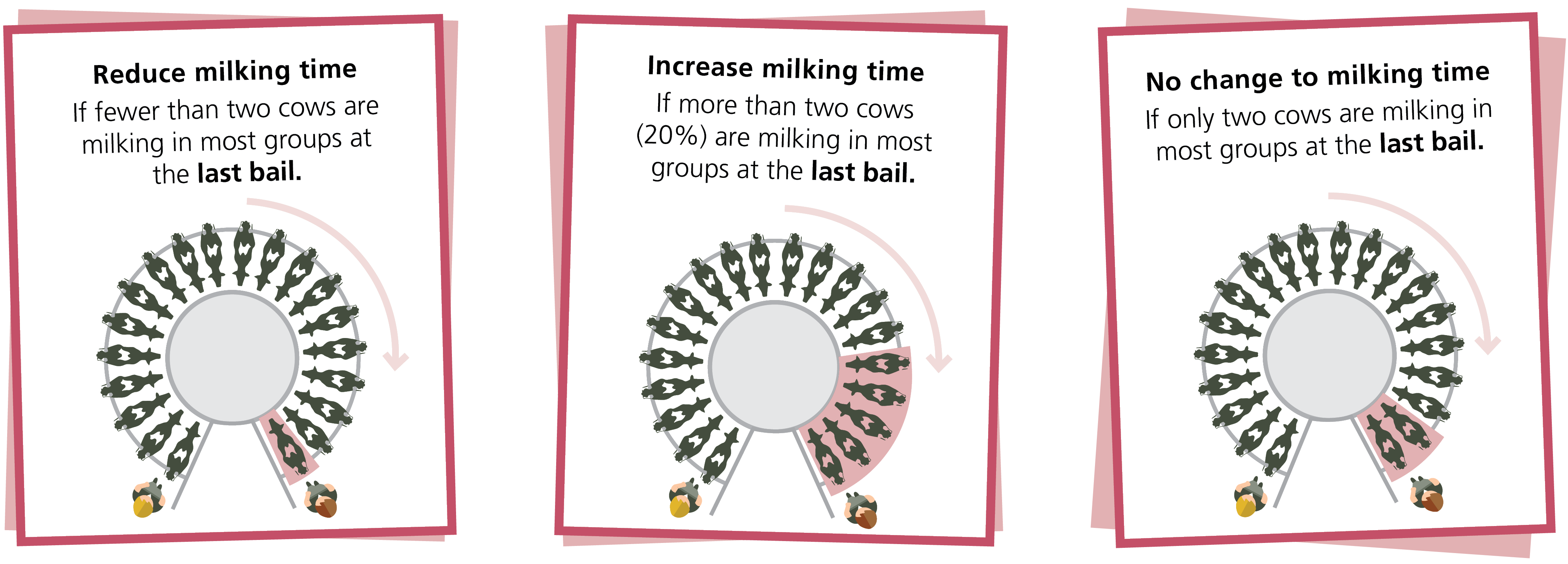Rotary MaxT
6 min read
Learn how to implement a maximum milking time (MaxT) in a rotary dairy. MaxT is a strategy to milk cows for a predetermined time based on their milk volume. This efficient milking solution results in less time in the dairy for staff and cows, without affecting milk production or udder health. Explore common questions that famers have about MaxT.

There are three steps to implementing MaxT: calculate, implement and monitor.
The first step is to determine your MaxT time. The easiest way to do this is to download DairyNZ’s Milksmart app. By entering the number of litres from the tanker docket, the number of cows going in the vat and your milking start times, the app will calculate the average milk volume per cow for each milking, and the appropriate MaxT time for this volume.
Alternatively, use these tables below to calculate your MaxT time manually.
Note: Farmers implementing MaxT for the first time have found it easier to start with using the morning MaxT time and monitoring at cups off as per Step 3.

Video 1:10 min
Before milking, for a range of platform speeds, time how long a bail takes from ‘cups on’ to ‘cups off’ (or before teat spray).
A shortcut to save time:
If you have Automatic Cup Removers (ACR)
Just about every ACR has the functionality of applying a maximum milking time except the Waikato Ultimate, although there is an upgrade available for this model. Some models of Delaval and GEA may require a service technician to change the maximum time setting. If this is the case, at the start of the season choose a time to handle peak milk and plan to change the MaxT time 2-3 times during the season. Contact your service technician if you have further questions.
Some ACR models can take the cups off at a set point in the rotation (point take-off), i.e. just before the teat sprayer and/or exit on the bridge. If you have this capability, setting the correct platform speed and maintaining it is extremely important.
At milking:
Both methods still require the correct platform speed to be set and maintained. Milkings should also be monitored and/or checks put in place to ensure the platform is not operated at faster speeds than those required to ensure the correct platform MaxT times.
Note: if part of the herd is milked once a day, put these cows in one herd and allow them additional time.
The final step is regular monitoring. Once a week at an afternoon milking, monitor five groups of 10 cows. When monitoring, look at the cows at the cups off position (i.e. once the cluster has been on for the MaxT time).

Read more about farmers common concerns about switching to MaxT in our FAQ section.
Using a MaxT specific for AM and PM milking can sometimes be impractical, for example when uneven milking intervals result in a target MaxT time as low as 5 minutes, or when ACRs settings have to be manually changed between milkings.
One solution is to use the morning MaxT time for both milkings, but this will result in reduced efficiency in the afternoons. Another is to make the milking intervals more even but that may mean milking at undesirable times of the day.
Another alternative option is FixedT – a MaxT based on the average yield per milking (see table below) applied at all milkings, ignoring differences in milking intervals. This shifts more milk from the longer milking to the shorter milking making both milkings more efficient while still allowing the milkings to occur at favourable times of the day.
A study at DairyNZ’s Lye farm tested FixedT for four milking intervals (TAD 8-16 h, TAD 10-14 h, 3-in-2 10-19-19 and OAD) at peak and mid-lactation, using a 70:30 pulsation ratio, and found no effect on udder health or milk production, when less than 33% of the herd had their milking shortened. For the 8-16 and 10-19-19 intervals, where one milking interval was 3-4 hours shorter than the others, the fat yield was reduced when more than 36% of cows were shortened.
Monitor the number of animals that have their milking shortened, as described in the MaxT pages, to ensure it is not more than 33%.
Find your FixedT time from the table below based on daily milk yield and milking frequency
| Daily milk yield | TAD Time | 3-in-2 Time | OAD Time |
| 12 | 04:40 | 05:40 | 07:20 |
| 14 | 05:00 | 06:00 | 08:00 |
| 16 | 05:40 | 06:40 | 09:00 |
| 18 | 06:00 | 07:20 | 09:40 |
| 20 | 06:20 | 08:00 | 10:20 |
| 22 | 07:00 | 08:20 | 11:00 |
| 24 | 07:20 | 09:00 | 11:40 |
| 26 | 07:40 | 09:20 | 12:20 |
| 28 | 08:00 | 10:00 | 13:00 |
| 30 | 08:40 | 10:20 | 13:40 |
| 32 | 09:00 | 11:00 | 14:20 |
| 34 | 09:20 | 11:20 | 15:00 |
| 36 | 09:40 | 11:40 | 15:40 |
Is MaxT too complicated?
Farmers who've adopted MaxT tell us that it simplifies the milking routine. The most complicated part is calculating the maximum milking time (MaxT), which is based on how long it will take 80% of your cows to finish milking. When implementing for the first time, MaxT is typically applied at the morning (highest volume) milking. Calculate your MaxT time with the DairyNZ Milking App (Apple App store and Google Play store).
Rotary: the MaxT time is the time taken from cups on to cups off. Once you’ve set the platform speed to achieve this time, remove the cups from all cows at the end of their first rotation, either with the automatic cluster removers (ACRs) or manually.
What if I can't do MaxT because I can't work any faster?
MaxT doesn’t mean you have to work faster. In most cases, you’ll be working at the same speed or more slowly.
Rotary: the platform speed is set to ensure about 80% of cows complete milking before the cups-off position. Milkers say cow exiting improves and they can focus on cupping cows.
How do I manage my in-shed feeding?
Meal feeding generally shouldn’t be a barrier to implementing MaxT. At peak milk, the full row/rotation time is likely to be between eight and 10 minutes, which should provide plenty of time for cows to finish their food ration. Farmers have found that, by implementing MaxT on rotary dairies with feeding meal, cow flow actually improves. The cows get used to exiting at the end of one rotation and there aren’t as many free-riders.
What if I have ACR's?
ACRs make implementing MaxT simple. For most devices, this is achieved by setting the ‘Maximum Time’ setting or ‘Point Takeoff’ setting (for rotaries) in the ACR to achieve the desired MaxT time (some models might need a modification from a service provider).
Another way is to lift the ACR low-flow threshold (similar to MaxT). For a rotary with one operator, set the platform speed to provide the required MaxT time between the cups-on and cups-off position, so more cows complete milking by the end of one rotation. Keep adjusting the low-flow threshold until you reach your desired balance.
What about pulsation ratios when doing MaxT?
Increasing pulsation ratio is a good strategy to reduce milking time in situations where the risk of overmilking is low – such as when using MaxT. Increasing the pulsation ratio will mean fewer cows are shortened than the estimated 20% for a given MaxT time. A key requirement when doing this is to achieve a d-phase of ≥ 20%.
Consult your milking machine technician to assist with changing your pulsation ratio.
Will MaxT cause mastitis?
No research or field study over the past 30 years has supported this theory. In fact, there’s a greater risk of mastitis when cows are overmilked at the end of milking. MaxT often results in a better let-down and removal of milk at the next milking for slower milking cows – and reduces overmilking for the rest of the herd.
Research shows that when a 500mL of strip milk is routinely left in the udder after milking, there’s no detectable increase in cell counts for both infected and uninfected quarters.
Will MaxT increase my bulk SCC?
Anecdotally, we know that herds milked using MaxT often see a decrease in somatic cell count (SCC). As mentioned earlier, there’s a greater risk of teat congestion, damage and mastitis when cows are overmilked at the end of milking.
Contrary to common myths, using MaxT and leaving milk behind in the udder has no negative effects on milk quality, milk production or somatic cell counts.
What if my cows produce too much milk to use MaxT?
Research in high-producing overseas systems does not support this theory. The most comparable study was in Denmark, where there was no significant difference in milk production or udder health when the ACR low-flow limit was doubled from 0.2 to 0.4kg/min, and cows were averaging 2.5kg MS/cow/d (32kg milk/cow/day).
Can you only use MaxT if you are milking TAD?
Although there's been no research yet to specifically test MaxT with milking three times in two days (3-in-2) or once a day (OAD), farmer feedback suggests it can work successfully. DairyNZ is expected to begin an experiment into this in October 2020.
Now’s the perfect time to check in, plan, and set up for a strong season. We’ve pulled together smart tips and tools to help you stay ahead all winter long.
Whether you prefer to read, listen, or download handy guides, we’ve got you covered with trusted tools to support your journey every step of the way.
Put our proven strategies and seasonal tools to work. Boost production, support animal health and watch your profits hum.
Tools that are backed by science, shaped by farmers and made for this season.
That’s Summer Smarts.